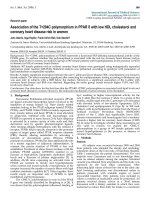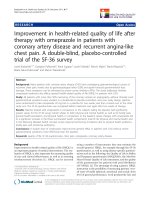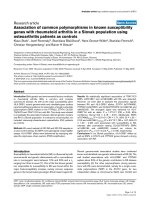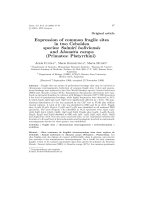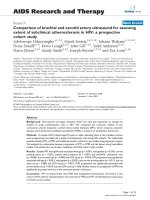tudies of common variations in two candidate genes of dyslipidemia and coronary artery disease
Bạn đang xem bản rút gọn của tài liệu. Xem và tải ngay bản đầy đủ của tài liệu tại đây (1.03 MB, 186 trang )
STUDIES OF COMMON VARIATIONS IN TWO
CANDIDATE GENES OF DYSLIPIDEMIA AND
CORONARY ARTERY DISEASE
HE XUELIAN
NATIONAL UNIVERSITY OF SINGAPORE
2007
STUDIES OF COMMON VARIATIONS IN TWO
CANDIDATE GENES OF DYSLIPIDEMIA AND
CORONARY ARTERY DISEASE
HE XUELIAN
(BACHELOR OF MEDICINE)
A THESIS SUBMITTED
FOR THE DEGREE OF DOCTOR OF PHILOSOPHY
DEPARTMENT OF PAEDIATRICS
NATIONAL UNIVERSITY OF SINGAPORE
2007
i
CONTENTS
ACKNOWLEDGEMENTS……………………………………………… ………….ii
LIST OF ORI GANAL PUBLICATIONS………………………………… ………iii
TABLE OF CONTENTS…………………………………………………………… iv
SUMMARY……………………………………………………………………… ….v
LIST OF ABBREVIATIONS…………………………………………………… ….x
LIST OF TABLES………………………………………………………… ……….xii
LIST OF FIGURES…………………………………………………………… … xiv
ii
ACKNOWLEDGEMENTS
This study was carried out at the Department of Paediatrics, Yong Loo Lin School of
Medicine at the National University of Singapore during the years 2002 to 2004. I
wish to express my greatest gratitude to my supervisor, Dr Heng Chew Kiat. His
profound knowledge in lipid metabolism and in candidate gene study and in statistics
has given me great help in this project. I am indebted to him for sharing his
constructive criticism of the publications related this project and for his support
throughout my whole graduate study.
I would like to express my appreciation to Dr Yang Hongyuan from Department of
Biochemistry, National University of Singapore, for providing excellent research
facilities and reagents for the functional study of ACAT2 gene.
I thank also Lu Yongjian for his guidance and sharing his experience in SNP
discovery work and genotyping.
I thank my friends and colleagues for their generous help when I was in need.
I am extremely indebted to family members, especially parents, the best parents. I was
always provided with delicious food after work during the period that they stayed
with me. They have always supported me and their love has been endless and
invaluable through my whole life.
Finally, I thank my dear husband and my two lovely sons, and their love and support
have been most important to me.
iii
LIST OF ORI GANAL PUBLICATIONS
Posters in conferences
1. Xuelian He, Yongjian Lu, Chew Kiat Heng, Robert Hongyuan Yang,
Identification of Novel Polymorphisms in the Acyl-CoA: Cholesterol
Acyltransferase-2 Gene and Their Impact on Plasma Lipid Levels, The 1
st
Bilateral Symposium on Advances in Molecular Biotechnology and
Biomedicine between the National University of Singapore and University of
Sydney, 23-24 may, 2002
2. Xuelian He, Yongjian Lu, Nilmani Saha, Hongyuan Yang, Chew-Kiat Heng,
Identification of Novel Polymorphisms in the Human Acyl-CoA: Cholesterol
Acyltransferase-2 Gene and Association Study with Lipids and Coronary
Artery Disease, 54
th
Annual Meeting of The American Society of Human
Genetics. 26-31 October, 2004
Articles
1. Xuelian He, Yongjian Lu, Hongyuan Yang, Chew-Kiat Heng, Acyl-CoA:
Cholesterol Acyltransferase-2 Gene Polymorphisms and Their Association
with Plasma Lipids and Coronary Artery Disease Risks,
Hum Genet. 2005
Dec;118(3-4):393-403.
2. Xuelian He, Hongyuan Yong, Chew-Kiat Heng, Functional analysis of
ACAT2 polymorphisms, submitted.
3. Chew-Kiat, Heng Xuelian He, Hongyuan Yong, Association of three
lipoprotein lipase polymorphisms with Coronary artery disease in Chinese and
Asian Indians, submitted.
iv
TABLE OF CONTENTS
1. INTRODUCTION AND BACKGROUND…………………………………………
1.1. Introduction………………………………………………………………………
1.2. Background ……………………………………………………………………
1.3. Objectives of this study……………………………………………………………
1.3.1. Study on ACAT2 gene……………………………………………………….
1.3.2. Study on LPL gene…………………………………………………………
1.4. Significance and limitation of this study…………………………………………
2. LITERATURE REVIEW…………………………………………………………….
2.1. Coronary artery disease (CAD)…………………………………………………
2.1.1. Definition of CAD…………………………………………………………
2.1.2. Prevalence of CAD………………………………………………………….
2.1.3. Pathophysiology and pathogenesis of CAD………………………………….
2.1.4. Genetics of CAD…………………………………………………………….
2.2. Genetic epidemiological study of complex disease……………………………….
2.2.1. Genetic variations…………………………………………………………
2.2.2. The discovery of genetic variants……………………………………………
2.2.2.1. Single-strand confirmation polymorphism (SSCP)…………………….
2.2.2.2. Cleavage fragment length polymorphism (CFLP)……………………
2.2.2.3. Denaturing gradient gel electrophoresis (DGGE)……………………
2.2.2.4. Denaturing high performance liquid chromatography (DHPLC)……
2.2.3. Complex diseases…………………………………………………………….
2.2.4. Approaches for genetic study of complex diseases…………………………
2.2.4.1. Family-based genome-wide linkage studies……………………………
2.2.4.2. Association studies……………………………………………………
2.2.4.2.1. Candidate-gene association studies……………………………
2.2.4.2.2. Genome-wide association studies…………………………………
2.2.4.2.3. Association tests…………………………………………………
2.5.4.2.4.Data analyis of association studies…………………………………
2.3. Dyslipidemia……………………………………………………………………
2.3.1. Lipids and lipoproteins……………………………………………………
2.3.2. Definition of dyslipidemia ………………………………………………
2.3.3. Dyslipidemia and CAD…………………………………………………….
2.3.4. Genetics of dyslipidemia…………………………………………………
.
2.4. Acyl-coenzyme A: cholesterol acyltransferase (ACAT)…………………………
2.4.1. Identification of ACAT2……………………………………………………
2.4.2. Distribution and function of ACAT2……………………………………….
2.4.3. ACAT2 and atherosclerosis…………………………………………………
2.4.4. ACAT2 protein structure …………………………………………………
2.4.5. ACAT2 genomic organization and the regulation of ACAT expression ……
2.4.6. Genetic analysis of ACAT2…………………………………………………
2.5. Lipoprotein lipase (LPL)…………………………………………………………
2.5.1. Function and localization of LPL…………………………………………
2.5.2. LPL and atherosclerosis……………………………………………………
1
1
1
4
4
5
6
9
9
9
9
10
12
15
15
17
17
18
18
19
21
22
22
23
23
25
26
27
29
29
29
30
32
33
34
35
36
37
38
40
40
40
42
v
2.5.2.1. The anti-atherogenic effects of LPL……………………………………
2.5.2.2. The pro-atherogenic actions of LPL……………………………………
2.5.3. The organization of LPL protein and gene …………………………………
2.5.4. Genetic analysis of LPL……………………………………………………
3. MATERIALS AND MTHODS……………………………………………………….
3.1. Subjects……………………………………………………………………………
3.2. DNA analysis ……………………………………………………………………
3.2.1. DNA Extraction…………………………………………………………….
3.2.2. Primer design for polymorphism screening of ACAT2 gene……………….
3.2.3. PCR amplification…………………………………………………………
3.3. Survey of genetic variant in ACAT2 gene from public resources…………………
3.4. DHPLC analysis…………………………………………………………………
3.5. Sequencing………………………………………………………………………
3.6. Predicting biological impact of ACAT2 polymorphisms …………………………
3.7. Genotyping of ACAT2 gene Polymorphisms…………………………………….
3.8. Genotyping of three LPL gene polymorphisms………………………………….
3.9. Estimation of plasma lipid levels………………………………………………
3.10. Statistical analysis……………………………………………………………….
3.11. Cell line, vector and reagents…………………………………………………
3.12. Cell culture……………………………………………………………………
3.13. Expression of various ACAT2 proteins…………………………………………
3.13.1. Construction of various ACAT2 gene expression plasmids ………………
3.13.2. Transfection of AC-29 with various pcDNA3.1/His/ACAT2……………
3.13.3. Selection of stable transformants…………………………………………
3.13.3. Selection of positive stable transformants………………………………
3.14. Ex vivo ACAT activity assay……………………………………………………
3.15. Quantitative reverse transcription PCR…………………………………………
3.16. Western blot…………………………………………………………………….
4. STUDY OF ACAT2 GENE……………………………………………………………
4.1. Introduction………………………………………………………………………
4.2 Results…………………………………………………………………………….
4.2.1. Polymorphism screening…………………………………………………
4.2.1.1. Survey of known genetic variants in ACAT2 gene…………………
4.2.1.2. Polymorphism screening ……………………………………………
4.2.1.3. Improved efficiency of mutation screening using modified primer ….
4.2.1.4. Factors affecting DHPLC elution profiles…………………………….
4.2.1.5. Prediction of functional implications of ACAT polymorphisms………
4.2.2. Association studies of ACAT2 gene ……………………………………….
4.2.2.1. Genotyping of three polymorphisms …………………………………
4.2.2.2. Population Demographics……………………………………………
4.2.2.3. Genotype and allele frequencies………………………………………
4.2.2.4. Linkage disequilibrium among the three polymorphisms ……………
4.2.2.5. Multi-loci case-control analysis……………………………………….
4.2.2.6. Association of single-locus genotype with lipid traits in CAD
subjects…………………………………………………………………………………
4.2.2.6.1. c. 734C>T……………………………………………………………
4.2.2.6.2. D/I……………………………………………………………………
42
43
44
44
48
48
49
49
50
52
52
52
54
55
57
58
59
61
62
63
63
63
65
66
66
67
68
70
71
71
71
71
71
72
79
81
81
85
85
85
89
90
91
97
97
98
vi
4.2.2.6.3. c. 41A>G…………………………………………………………….
4.2.2.7. Association of diplotypes with lipid traits …………………………….
4.2.3. Functional analysis of two nsSNPs of ACAT2 gene………………………
4.2.3.1. Expression of ACAT2 in AC-29 cell………………………………….
4.2.3.2. ACAT2 activity assay…………………………………………………
4.3. Discussion…………………………………………………………………………
5. ASSOCIATION STUDY OF THREE LPL POLYMORPHISMS IN CHINESE AND
ASIAN INDIANS…………………………………………………………………………
5.1. Introduction……………………………………………………………………….
5.2. Results…………………………………………………………………………….
5.2.1. Demographic characteristics of subjects……………………………………
5.2.2. Genotyping of three LPL polymorphisms…………………………………
5.2.3. Distribution of three LPL polymorphisms………………………………….
5.2.4. Hapolotype distribution …………………………………………………….
5.2.5. Association with plasma lipid levels………………………………………
5.3. Discussion………………………………………………………………………
6. REFERENCES
98
98
104
104
104
107
119
119
120
120
122
122
124
129
133
137
vii
SUMMARY
Coronary artery disease is a disorder with multiple genetic and environmental factors
and dyslipidemia is one of most prominent risk factors. The major purpose of this
study is to determine the influence of some of the genetic factors on CAD
susceptibility and on plasma lipid traits.
Acyl-CoA: cholesterol Acyltransferase-2 (ACAT2) catalyzes the formation of
cholesteryl esters using cholesterol and long-chain fatty acids as substrates. As such
ACAT2 is a very important enzyme in the intestinal cholesterol absorption and in the
production of apoB-containing lipoproteins in the liver. ACAT2 has been
demonstrated to be a potential target for treating coronary artery atherosclerosis in
hypercholesterolemic animal model.
In order to explore the effects of genetic variations in the ACAT2 gene, we screened
for variants on its entire coding regions, intron-exon boundaries, and putative
promoter region, using denaturing high performance liquid chromatography. A total
of 14 polymorphisms were identified. These included three missense mutations,
namely c. 41A>G (Gly>Glu) in exon1; c.734C>T (Thr>Ile) in exon7; and c.1291G>T
(Ala>Ser) or G>A (Ala>Thr) in exon13; two base changes in putative promoter
region (-331C>T and -440G>T), two synonymous exonic base changes (c.609G>T
and c. 610C>T in exon6), seven intronic sequence variations, comprising six single
base substitutions (IVS1-8C->G; IVS4+172T/G, IVS5-137A/T, IVS9-178G/C,
IVS9+37A->T and IVS9+51G->T) and one 48bp insertion. Among these, 3
polymorphisms, 41A>G (Glu
14
Gly), 734C>T (Thr
254
Ile), and IVS4-57_58ins48bp,
were analyzed for their association with CAD and plasma lipid levels. A total of 2113
viii
subjects, comprising 1228 Chinese, 367 Malays, 518 Indians, were included in this
case-control association study. We found these three ACAT2 polymorphisms showed
significant ethnic variations in allele frequencies as well as significantly different
effects on plasma lipid levels and CAD risk, though some significances were not
observed after Bonferroni correction.
In addition, in vitro experiments were carried
out to determine the expression levels of ACAT2 wild type and mutant proteins and
their enzymatic activities in the ACAT-deficient AC-29 cells. The results showed that
the enzymatic activity of mutant Glu14Gly was about two times higher compared to
that of the wildtype ACAT2, and this increase was mostly due to the higher
expression and/or stability of the mutant ACAT2 protein. Our observations suggest
that the Glu
14
Gly polymorphism might be very important to ACAT2 protein
expression and/or stability.
ix
Another important enzyme, lipoprotein lipase (LPL), the rate-limiting enzyme in
hydrolysis of triglycerides in chylomicron and very-low-density lipoprotein particles,
was analyzed in this study. LPL has a paradoxical role in the development of
atherosclerosis as it can be considered both anti-atherogenic and pro-atherogenic.
There is no uniform consensus regarding the association of genetic variations in LPL
with CAD susceptibility and lipid levels. In addition, it is interesting to evaluate the
impact of the combination of IVS6+1594C>T, IVS8+483T>G, and c.1342C>G
polymorphisms in Asian populations. Our study showed that the most prevalent CTC
haplotype of three LPL polymorphisms was consistently associated with increased
CAD susceptibility in male Chineses and Indians living in Singapore. In addition, the
rare alleles of three individual polymorphisms were also found to lower CAD risk in
male Chinese and/or Indians, which is independent of any effect on lipid profile.
x
LIST OF ABBREVIATIONS
5’UTR
ABC
ACAT
ANOVA
Apo
ARE
ARH
ATP
ATP
CBS
CAD
cDNA
Cdx-2
CE
CEBP
CHD
CFLP
CVD
DEP
DGGE
DGAT
DHPLC
dNTP
ER
FLLD
HDL
HMG-CoA
HNF-3b
HSPG
HWE
HAEC
HGVbase
IDL
JSNP
LACT
LD
LDL
LDLR
LPL
MEF2A
MI
Min
MTP
NCBI
NCEP
NHGRI
nsSNP
PBS
5’ untranslation region
ATP-binding cassette
Acyl-CoA enzyme cholesterol transferase
Analysis of variance
Apoliproprotein
ACAT-related sterol-esterifying enzymes
Autosomal recessive hypercholeterolemia
Adenosine triphosphate
Adult treatment panel
Cystathionine β-synthase
Coronary artery disease
Coding deoxyribonucleic acid
Caudal type homeo box transcription factor 2
Cholesteryl ester
CCAAT/enhancer binding protein
Coronary heart disease
Cleavage fragment length polymorphism
Cardiovascular disease
diethyl pyrocarbonate
Denatureing dradient gel electrophoresis
Diacylglycerol acyltransferase
Denaturing high performance liquid chromotography
Deoxynucletides (dATP, dCTP, dGTP, dTTP)
Endoreticulum
Familial LPL deficiency
High density lipoprotein
Hydroxamethylglutaryl-CoA
Hepatocyte nuclear factor-3b
Heparin sulphate-proteoglycans
Hardy-Weinberg Equilibrium
human aortic endothelial cell
Human Genome Variation database
Intermediate density lipoproteins
Japanese SNPs
Lecithin:cholesterol acyltransferase
linkage disequilibrium
Low density lipoprotein
Low density lipoprotein receptor
Lipoprotein lipase
Myocyte enhancing factor-2
Myocardial infarction
Minutes
Microsomal triglyceride transfer protein
National Center for Biotechnology Information
National cholesterol education programme
National Human Genome Research Institute
Non-synonymous single nucleotide polymorphism
Phosphate Buffered Saline
xi
PCR
RFLP
SDS
S
SNP
SREBP
SSCP
STR
TSC
TEAA
TG
TMD
VNTR
VCAM
VLDL
VSMC
Polymerase chain reaction
Restriction fragment length polymorphism
Sodium dodecyl sulphate
Seconds
Single nucleotide polymorphism
Sterol regulatory element binding protein
Single-Strand Conformation Polymorphism
Short tandem repeat
the SNP consortium
Triethylammonium acetate
Triglyceride
Transmembrane domain
variable number of tandem repeats
Vascular cell adhesion molecule
Very low density lipoprotein
Vascular smooth muscle cells
xii
LIST OF TABLES
Table 2-1. Mendelian diseases relevant to premature CAD.
Table 3-1. PCR primers and DHPLC conditions.
Table 3-2. Primers and conditions for gentotyping three LPL polymorphisms.
Table 4-1. Polymorphisms in the ACAT2 gene found in this study and searched
from SNP databases.
Table 4-2. Demographics of the Singaporean subjects.
Table 4-2(Continued). Demographics of the Singaporean subjects.
Table 4-3. Genotype and allele frequencies of the ACAT2 polymorphisms in the
three Singaporean ethnic groups.
Table 4-4. Genotype and allele frequencies (freq) of 734C>T, D/I and 41A>G
in the normolipidemic (Normo) and dyslipidemic (Dys) subjects.
Table 4-5. Linkage disequilibria between the 3 polymorphisms of ACAT2 gene
Table 4-6. Haplotype frequencies for 41A>G and 734C>T in CAD+ and CAD-
subjects as well as in normolipidemic and dyslipidemic various groups.
Table 4-7. Genotypic lipid levels of the 734C>T in the healthy normolipidemic
Chinese, Malay and Indian females.
Table 4-8. Genotypic lipid levels of the D/I in the healthy normolipidemic
Chinese, Malay and Indian females.
Table 4-9. Genotypic lipid levels of the 41A>G in the healthy female
normolipidemic Chinese, Malays and Indians.
Table 4-10. Diplotypic lipid levels in normalipidemic Malay and Indian
females.
Table 5-1. Demographics of Chinese and Indian male subjects.
Table 5-2. Distribution of LPL polymorphisms in male CAD patients and
controls.
Table 5-3. Distribution of LPL polymorphisms in dyslipidemic and
normolipidemic subjects.
Table 5-4. Linkage disequilibria correlation coefficient (∆) between two loci in
Chinese and Indians.
Table 5-5. Haplotype frequencies for three polymorphisms in CAD patients and
control subjects.
Table 5-6. Haplotype frequencies for three polymorphisms in dyslipidemic and
14
51
59
74
87
88
93
94
95
96
100
101
102
103
120
125
126
127
128
129
xiii
normolipidemic subjects.
Table 5-7. Genotypic lipid levels of three polymorphisms in the healthy
Chinese males.
Table 5-8. Genotypic lipid levels of three polymorphisms in the healthy
normolipidemic Chinese males.
131
132
xiv
LIST OF FIGURES
Figure 2-1. The principle of the DHPLC.
Figure 4-1. DHPLC profiles of ACAT2 polymorphisms.
Figure 4-2. DNA sequencing results of ACAT2 polymorphisms detected in
this study.
Figure 4-3. DHPLC profile of ACAT2 IVS4-57_58ins48bp.
Figure 4-4. Sequencing result of ACAT2 IVS4-57_58ins48bp.
Figure 4-5. DHPLC profiles for IVS9+51G>T and IVS9+37A>T and the
wild type using unclamped and with GC-clamp primers.
Figure 4-6. Predicted melting profile of the fragment containing exon 9.
Figure 4-7. DHPLC profile of the fragment containing exon 8 of ACAT2
gene.
Figure 4-8. Multiple alignments of ACAT2 protein orthologs from Homo
sapiens, Africa green monkey, Mus musculus and Rattus norvegicus using
CLUSTAL W ver.1.82.
Figure 4-9. Multiple alignments of acyltransferase family members:
ACAT1, ACAT2, Are1P, Are2p, DGAT1, and DGAT2.
Figure 4-10. Genotyping results of three ACAT2 gene polymorphisms.
Figure 4-11. Cells viewed with inverted microscope.
Figure 4-12. ACAT2 mRNA and protein expression in AC-29 cells.
Figure 4-13. ACAT2 enzyme activity analysis of wild type and mutant
ACAT2s.
Figure 5-1. Genotyping of three LPL polymorphisms.
20
75
76-77
78
78
80
80
81
83
84
85
105
105
106
122
1
1. INTRODUCTION AND BACKGROUND
1.1. Introduction
Coronary artery disease (CAD) is a complicated disease with multiple genetic and
environmental contributions, such as dyslipidemia, hypertension, diabetes mellitus,
obesity, cigarette smoking, high-fat and high-cholesterol diet, and physical inactivity.
Among these risk factors, dyslipidemia is the most important contributor to CAD
susceptibility. Dyslipidemia can be caused by monogenic disorders, such as familial
hypercholesterolemia (Brown and Goldstein, 2001), and familial defective
apolipoproetin (apo) B (Fisher et al., 1999). Studies on these monogenic disorders
have helped to unravel the pathways of cholesterol metabolism regulation and
contributed importantly to the understanding of lipid metabolism and atherosclerosis.
However, most cases of dyslipidemia are attributed to a combination of many
common genetic variations and environmental factors and our understanding of these
aspects remains incomplete. Study on such genetic variants of candidate genes in
lipid metabolism would contribute towards elucidating the genetic mechanisms of
CAD and dyslipidemia.
1.2. Background
Given the prominent role of dyslipidemia in atherosclerosis, genetic studies on
enzymes which are important to lipid and lipoprotein metabolism have captivated
generations of researchers.
A relatively novel protein, acyl CoA: cholesterol acyltransferase (ACAT)2, an
enzyme which converts cholesterol into cholesterol esters (CEs) (Chang et al., 1997),
2
has been shown to be associated with hypercholesterolemia and atherosclerosis using
ACAT2-/- mice model (Buhman et al., 2000). Furthermore, the deletion of ACAT2 has
been demonstrated to be consistently athero-protective (Willner et al., 2003; Lee et al.,
2004). Thus, selective inhibition of ACAT2 would be an important strategy for
treatment and prevention of atherosclerosis (Rudel et al., 2005). The ACAT2, also
called Soat2, should not be confused with acetyl-Coenzyme acetyltransferase 2, which
is also denoted as ACAT2.
Another important protein, lipoprotein lipase (LPL), is the rate-limiting enzyme
responsible for the hydrolysis of triglycerides (TGs) in chylomicrons and very low
density lipoproteins (VLDL). This hydrolysis functions to clear TGs from the
circulation and also provides phospholipids and apolipoproteins to high-density
lipoprotein (HDL) cholesterol, therefore, driving the plasma lipids in anti-atherogenic
direction. The familial deficiency of LPL may lead to type I hyperlipidemia,
characterized by severe hypertriglyceridemia and extremely low HDL levels (Brunzell,
1995). Even heterozygous LPL mutations may result in reduced or loss of LPL
activity and increased risk of familial combined hyperlipidemia (Babirak et al., 1992).
On the other hand, LPL also has a non-enzymatic molecular bridging function and has
been shown to act as a ligand to mediate cellular uptake of lipoproteins and CEs
(Stein and Stein, 2003). Furthermore, LPL has been shown to stimulate the
proliferation of vascular smooth muscle cells (VSMC) (Mamputu et al., 2000). Hence,
LPL may also have pro-atherogenic effects. Whether LPL acts to be anti-atherogenic
or pro-atherogenic depends on the tissues specifically expressing LPL (Mead and
Ramji, 2002).
3
Because of their crucial roles in lipid metabolism and atherogenesis, the ACAT2 and
LPL are considered as important candidate genes in studies to determine whether they
contribute to predisposition for dyslipidemia and atherosclerosis.
Singapore is a small immigrant nation in Southeast Asia comprising different ethnic
groups: Chinese (77.4%), Malays (14.2%), Indians (7.2%) and European Caucasians
(0.2%). The ancestors of the Chinese were mostly migrants from the coastal regions of
southern China. The Malays came from neighboring Malaysia and Indonesia. Most
Indian Singaporeans are second, third or even fourth generation descendants of migrants
from the southern Indian subcontinent.
Over the past few decades, Singapore has witnessed a high degree of social and
political stability and a rapid-growth economy since it obtained independence in 1965.
Since 1980, Singapore has been considered a fully urbanized and developed city-state.
With the rapid socioeconomic development, some “modern diseases”, such as
cardiovascular diseases and cancer, have become the major causes of morbidity and
mortality in this population. Among them, CAD is the leading cause of death in this
population.
Each of the ethnic groups residing in Singapore has contrasting mortalities due to
CAD (Hughes et al., 1990
a
; Hughes et al., 1990
b
; Heng et al., 1999), though they
reside in the same physical environment and environmental factors are relative
constant except their habitual diets, and culturally determined lifestyles. Thus,
Singapore offers the advantage for the genetic study of ethnic differences in CAD risk
4
1.3. Objectives of this study
1.3.1. Study on ACAT2 gene
Although ACAT2 has been shown to be associated with hypercholesterolemia and
atherosclerosis in animal models (Buhman et al., 2000), studies on the effects of
genetic variants of this gene on CAD susceptibility have not been performed in the
general population. There was only one other genetic study which explored the
association of two ACAT2 polymorphisms, Glu14Gly and Thr254Ile, with
dyslipidemia in Japanese when this study was initiated in the Singaporean population
(Katsuren et al., 2001). In 2003, a similar study on another polymorphic site,
IVS1-8G>C, was reported by the same group (Katsuren et al., 2003). Their studies did
not reveal any positive association except with plasma apoIII level, which was found to
be higher in Thr254Ile heterozygotes (Katsuren et al., 2001). However, no further
functional study on the genetic variant was carried out.
Based on the significant effects of ACAT2 on atherosclerosis in ACAT2-/- mice
(Buhman et al., 2000), it was hypothesized that genetic variants of ACAT2 gene could
exert an important influence on susceptibility to CAD and dyslipidemia in the general
population. The Singaporean population is made up of multiple ethnic groups, namely,
Chinese, Malays, and Indians. It is also therefore worthwhile to determine if the effect
of ACAT2 variants is ethnic-specific.
The following steps were taken to verify these hypotheses:
1. To identify novel polymorphisms of the ACAT2 gene using denaturing high
performance liquid chromatography (DHPLC) and to predict their possible
biological function using computational approaches
5
2. To determine the impact of the ACAT2 gene polymorphisms on CAD susceptibility
and plasma lipid levels in three major ethnic groups in Singapore using
population-based case-control association study
i. To determine the allele frequencies of ACAT2 polymorphisms between
CAD patients and healthy control, as well as between the normolipidemic
and dyslipidemic subgroups
ii. To determine the allele frequencies of the ACAT2 polymorphisms in the
three ethnic groups, and
iii. To evaluate the effect of these polymorphisms on plasma lipid profiles in
different population subgroups,
3. To conduct an in vitro functional study of two potential functional polymorphisms in
mammalian cells.
1.3.2. Study on LPL gene
Three common genetic variants, IVS6+1595C>T, IVS8+484T>G, and c.1342C>G of
the LPL gene, have been reported to be associated with abnormal lipid concentrations
and atherosclerosis. Though these three polymorphisms have been extensively studied,
there is no uniform consensus on their effects on CAD susceptibility and plasma lipid
concentrations. Furthermore, most studies were conducted in Caucasian populations,
with only a few that had examined the Asian populations (Shimo-Nakanishi et al.,
2001; McGladdery et al., 2001; Hall et al., 2000; Lee et al., 2004; Liu et al., 2004).
In addition, to our knowledge, the combined effect of these three polymorphisms on
CAD risk has not been determined in an Asian population. In this study, it was
evaluated whether these polymorphisms are associated with CAD risk and with
abnormal lipid traits. The combined effect of these three polymorphisms on CAD risk
6
was also explored in two Asian ethnic groups with contrasting CAD risk, namely, the
Indians and Chinese. In addition, the different distribution of allele frequencies
between different ethnic groups was compared.
1.4. Significance and limitation of the study
CAD is the most common cause of death in developed countries and its prevalence is
rapidly increasing in developing countries owing to the burgeoning epidemic of
obesity and the aging population. For the treatment of CAD, other than modifying
lifestyle risk factors, pharmacological intervention is an important strategy. The
determination of specific susceptibility genes and these disease-associated genetic
variants will contribute to the development of new drugs. In addition, the
identification of high-risk individuals would be important for the efficient prevention
of CAD and dyslipidemia. However, although many candidate genes and genetic
variants related to CAD and dyslipidemia have been reported, the available data are
either inconclusive or inconsistent.
In our study, fourteen polymorphisms were identified in ACAT2 gene by screening
cord blood samples using DHPLC. Our association study showed that a
nonsynonymous SNP (nsSNP) in exon 7, 734C>T, was associated with decreased
CAD risk while another nsSNP in exon 1, 41A>G, had decreased dyslipidemia in
Chinese subjects, after correction for multiple comparisons. It was observed that these
two nsSNPs and IVS4-57_58ins48bp (D/I), a 48bp insertin in intron 4, were in strong
linkage disequilibrium (LD). The frequency of the most common AC haplotype of
these two nsSNPs was significantly increased in dyslipidemic subjects when
compared with normolipidemic ones in the Chinese. The CAD+ group had almost
7
2-fold higher GC haplotype frequency than the CAD- controls in the three ethnic
groups, but statistical significance was only attained in the Chinese. However, the
normolipidemic subjects had about 3-fold higher GC haplotype frequency than
dyslipidemic ones in the Chinese and Malay groups, although the latter did not reach
a significant level. The preliminary results from the functional study of these two
nsSNPs suggested the 41A>G probably increased ACAT2 enzymatic activity by
altering protein expression and/or stability.
The identification of novel polymorphisms in ACAT gene would contribute to the
SNP database, which is very useful for genetic association studies. Secondly, our
association study would provide important information about the impact of ACAT2
and LPL polymorphisms with CAD and dyslipidemia. Furthermore, our preliminary
results from in vitro study would be helpful for the understanding of the relationship
between the structure and function of ACAT2 protein.
The study is not without its limitations, such as the age disparity between case and
control subjects and the relatively small sample size, especially after stratification by
gender, ethnic groups and lipid profiles. Hence, further study using a larger sample
size with well-matched case-control may be needed to confirm our current findings
related to association with CAD, dyslipidemia susceptibility and altered plasma lipid
profiles. In addition, although the functional study of nsSNPs of ACAT2 gene in
mammalian cell line have shown that the 41A>G (Glu14Gly) variant had significant
effects on ACAT2 enzymatic activity, only one colony for each ACAT2 polymorphic
type was examined. To verify the results obtained from functional study, at least
8
three colonies for each ACAT2 polymorphic types should be included in future
studies.
9
2. LITERATURE REVIEW
2.1. Coronary artery disease
CAD is the leading cause of death and disability in the developed world, with an
increasing prevalence (Bonow et al., 2002). In the last
30 years, dyslipidemia has
been identified as a major modifiable
risk factor for CAD (Willerson and Ridker,
2004). In the following sections, the clinical, etiological, and epidemiological
aspects of the most prominent risk factor, dyslipidemia, will be reviewed.
2.1.1. Definition of CAD
CAD, also called coronary heart disease (CHD) or ischemic heart disease (IHD), is
characterized by a “narrowing” of coronary arteries resulting in inadequate blood flow
to the heart muscle and leading to angina pectoris, with exertion or at rest, or
myocardial infarction (MI), and even sudden death, depending on the severity of
obstruction. The narrowing is usually caused by atherosclerosis.
2.1.2. Prevalence of CAD
CAD is a major cause of morbidity and is a leading contribution to mortality
worldwide, especially in developed countries (Murray and Lopez, 1997). According
to the Heart Disease and Stroke Statistics update 2005 from American Heart
Association (AHA), CAD caused 1 of every 5 deaths each year and every minute
someone will die from CAD in the United States. CAD is responsible for about
US$142.1 billion in 2005 in direct and indirect economic costs in the United States
(Heart Disease and Stroke Statistics – AHA 2005 Update). With the rapid economic
development and urbanization in Singapore, CAD has been the most common cause
